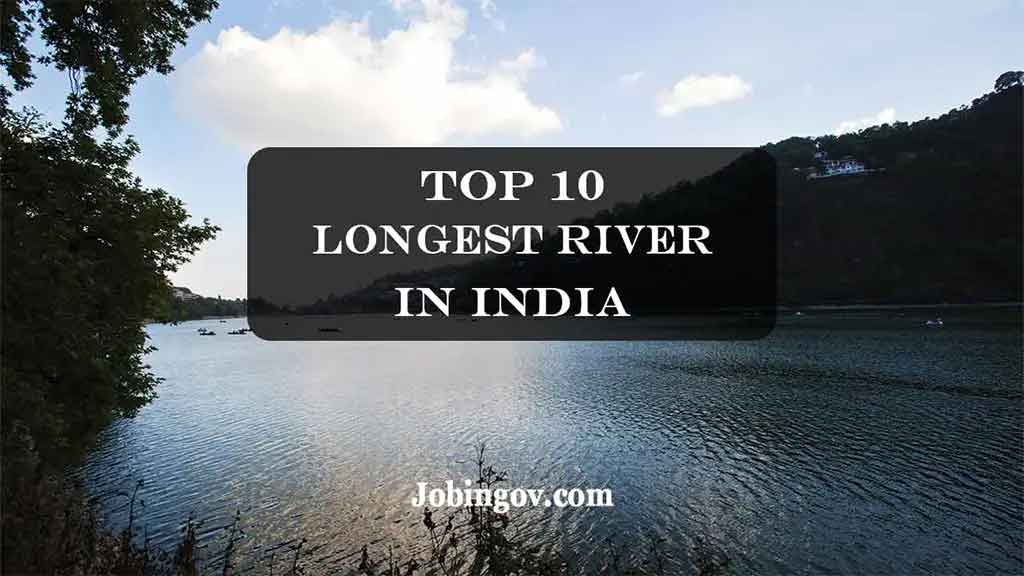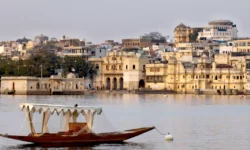Longest River in India 2023: India not only popular for its famous persons but also for its different rivers such as Ganga, Indus, Brahmaputra, Yamuna, Godavari etc. In India, rivers are emotionally attached to the people as Hindus worshipped some of them like gods and goddesses.
There are many rivers across the India which are flowing in different directions. In every country rivers plays vital role for the development of their economy.

If we analyze the origin of different rivers, they are divided into two parts (I) Himalayan or the Extra-Peninsular Rivers (Rivers originate from Himalayas) and (II) Peninsular Rivers (Have their origins in peninsular).
The rivers which originating from Himalayas are perennial as they get water from the melting of ice and on the other hand Peninsular Rivers are not perennial because they get water from rain.
Top 10 Longest River in India
Here, we are going to discuss briefly about top 10 longest river in India.
1. Ganga (2525 km, in India 2525 km)
Origin: Gangotri Glacier near Gaumukh, Uttarkashi, Uttaranchal.
Mouth: Bay of Bengal
Tributaries:
- Left Hand: Ramganga, Garra, Gomti, Ghaghara, Gandak, Burhi Gandak Koshi, Mahananda etc.
- Right Hand: Yamuna, Tamsa, Son, Punpun, Kiul, Karamnasa, Chandan etc.
States Covered: Uttarakhand, Uttar Pradesh, Bihar, and West Bengal.
The Ganga or Ganges, is longest as well as largest river of India. For Indian people, especially for Hindus, the Ganga is the most sacred river. At origin, it is known as Bhagirathi, from the Gangotri Glacier (near Gaumukh) at the height of 7010 m from sea level.
Alaknanda, which is originates from the Satopanth Glacier and Bhagirathi joins at Devprayag. Before this confluence, Alaknanda makes five confluences with its tributaries, popularly known as Panch Prayag. The Panch Prayags are:
- Alaknanda (Satopanth Glacier) + Dhauli Ganga (Mana Glacier) = Vishnu Prayag
- Alaknanda (Satopanth Glacier) + Nandakni (Trisul Glacier) = Nand Prayag
- Alaknanda (Satopanth Glacier) + Pindari (Pindari Glacier) = Karan Prayag
- Alaknanda (Satopanth Glacier) + Mandakni or Kali-Ganga (Chorabari Glacier) = Rudra-Prayag
- Alaknanda (Satopanth Glacier) + Bhagirathi (Gaumukh or Gangotri Glacier) = Dev-Prayag
After Dev-Prayag, this flows as Ganga. It flows through Hardwar and reach Allahabad where it joins with its longest tributary Yamuna.
Then, it crosses plains of Bihar and reach Rajmahal Hills where it bifurcated into the west as Hugli and west as Padma. After crossing West Bengal, it finally enters into the Bay of Bengal forming the world’s largest delta, Sundarban Delta near Sagar island, Haldia.
Pollution has adverse effects on the creatures such as 90 amphibian species, 140 fish species and the endangered Ganga river dolphin that lived within it.
Important cities on the bank of river Ganga are: Varanasi, Haridwar, Kanpur, Allahabad and Patna.
Also Read: Highest Waterfall in India
2. Godavari (1465 km, in India 1465 km)
Origin: From a spring, near Nasik, Maharashtra.
Mouth: Bay of Bengal
Tributaries:
- Left Bank tributaries: Banganga, Kadva, Shivana, Purna, Kadam, Pranahita, Indravati, Taliperu, Sabari, Maner, Penganga (confluence of Wardha and Wainganga)
- Right Bank tributaries: Nasardi, Darna, Pravara, Sindphana, Manjira, Manair, Kinnerasani.
States Covered: Maharashtra, Chhattisgarh, Telangana and Andhra Pradesh.
Dam/ Projects: The Gangapur Dam, The Jayakwadi Dam, The Sriram Sagar Project, The Polavaram Project, The Dowleswaram Barrage.
Next to Ganga, Godavari is the second largest river in India. Godavari starts its journey from Western Ghats near Trimbakeshwar, Nasik, Maharashtra. In South India, it is popularly known as “Dakshina Ganga” or Vridha Ganga (old Ganga).
In respect of length, it is the largest among South Indian rivers and also formed the second largest mangrove in India. It passes through Satmala hills on the north, Ajanta range and Mahadeo hills.
Some important cities through which it is flowing are Nashik, Nanded, and Rajahmundry. After completing a course of 1465 km finally drains into the Bay of Bengal near Rajahmundry creating delta.
3. Yamuna (1376 km, in India 1376 km)
Origin: Yamunotri glacier (6316 m), at Banderpoonch peak, Uttarkashi a district of Uttarakhand.
Mouth: Joins the Ganga at Allahabad.
Tributaries:
- Left bank tributaries – Hindon, Sharda, Giri, Rishiganga, Hanuman Ganga, Sasur Khaderi.
- Right bank tributaries – Chambal, Betwa, Ken, Sindh, Tons.
States Covered: Uttarakhand, Himachal Pradesh, Delhi, Haryana and Uttar Pradesh.
Dams/ Projects: Lakhwar-Vyasi multi-purpose dam.
Yamuna also known as Jamuna, the longest tributary of the Ganga, has its origin at Yamunotri glacier, Banderpoonch peak. It has no direct link with sea and it joins the Ganga river at Allahabad.
Yamuna river makes boundary between the two states Haryana and Uttar Pradesh, and after crossing some prominent cities such as Delhi, Mathura, Agra, it makes confluence with the Ganga at Allahabad.
Related Article – Top 10 Longest River Bridge in India for general knowledge
4. Narmada (1312 km, in India 1312 km)
Origin: Rises from Amarkantak, Madhya Pradesh.
Mouth: Gulf of Khambat (Arabian Sea)
Tributaries:
- Left Bank tributarties – Burhner River, Banjar River, Sher River, Shakkar River, Dudhi River, Tawa River, Ganjal River, Chhota Tawa River, Kaveri River, Kundi River, Goi River, Karjan River.
- Right Bank tributaries – Hiran River, Tendoni River, Choral River, Kolar River, Man River, Uri River, Hatni River, Orsang River.
States Covered: Madhya Pradesh, Gujarat, Maharashtra and Chhattisgarh.
Dams/ Projects: Indira Sagar, Sardar Sarovar, Omkareshwar, Bargi & Maheshwar.
The Narmada river rises from Amarkantak of Maikal range of Madhya Pradesh. This river is also known as Rewa or Nerbudda. While passing through marble gorges near Jabalpur, it forms a water fall known as Dhunwadhar (Cloud of Mist) Waterfalls (10m high). It crosses the Constant and the Satpura ranges and makes a wide estuary of 27 km before entering into the Gulf of Khambat (Arabian Sea).
5. Krishna (1300 km, in India 1300 km)
Origin: Near Mahabaleshwar, Western Ghats.
Mouth: Bay of Bengal.
Tributaries:
- Left Bank tributaries – Bhima, Dindi, Peddavagu, Musi, Paleru, Munneru.
- Right Bank tributaries – Venna, Koyna, Panchganga, Dudhaganga, Ghataprabha, Malaprabha, Tungabhadra.
States Covered: Maharashtra, Karnataka, Telangana, and Andhra Pradesh.
Dams/ Projects: Tungabhadra, Ghataprabha, Nagarjunasagar, Malaprabha, Bhima, Bhadra and Telugu Ganga.
The Krishna river is considered as the second largest river of peninsular India. It is surrounded by on the west Western Ghats, on the south-east Eastern Ghats and on the north Balaghat range. Approximately 75% of the total area is account for agricultural purpose. Pune, Hyderabad are the popular cities situated on the bank of Krishna river.
6. Indus (2880 km, in India 709 km)
Origin: Bokhar Chu (Glacier), Northern slopes of Kailash range (6714 m) near Manasarovar lake.
Mouth: Arabian Sea
Tributaries:
- Left Bank tributaries – Zanskar River, Suru River, Soan River, Jhelum River, Chenab River, Ravi River, Beas River, Sutlej River, Panjnad River, Ghaggar-Hakra River, Luni River.
- Right Bank tributaries – Shyok River, Hunza River, Gilgit River, Swat River, Kunar River, Kabul River, Kurram River, Gomal River, Zhob River.
States Covered: Jammu & Kashmir, Himachal Pradesh and Punjab.
Dams/ Projects: Mangla Dam, Tarbela Dam.
At the origin, it is known as Singi Khamban or Lion’s Mouth. Total length of the Indus river is 2880 km and out of which 709 km is within the boundary of India. One of the oldest civilization, the Indus Valley Civilization was flourished here and named after this river.
It enters J & K and passes through Ladakh, Gilgit, and Baltistan. At Nanga-Parbat, it takes a south-west turn to enter Pakistan. Near Karachi, it forms a large delta and merge with the Arabian Sea.
Also Read: List of Neighbouring Countries of India
7. Brahmaputra (2900 km, in India 916 km)
Origin: Originates from Angsi Glacier situated at the south-east of Kailash Mountain and Mansarovar lake, Tibet, China.
Mouth: Bay of Bengal
Tributaries:
- Left Bank tributaries – Dibang River, Lohit River, Dhansiri River, Kolong River.
- Right Bank tributaries – Kameng River, Manas River, Beki River, Raidak River, Jaldhaka River, Teesta River, Subansiri River.
States Covered: Arunachal Pradesh, Assam Dams /Projects: Doyang Hep Dam, Karbi Langpi Dam, Khandong Dam, Rangpo Dam.
In Tibet, the Brahmaputra river in known as Tsangpo (meaning ‘The Purifier’). After rising from Kailash Mountain it crosses Tibet and in Arunachal Pradesh enters into India. It flows through Assam and Arunachal Pradesh, enters into Bangladesh and finally meets the Bay of Bengal.
The Brahmaputra river basin is a flood prone area and also known as River of Sorrow. Famous the Kaziranga National Park and Majuli island is situated on the bank of Brahmaputra river.
8. Mahanadi (890 km, in India 890 km)
Origin: At Raipur, a district of Chhattisgarh.
Mouth: Bay of Bengal
Tributaries:
- Left Bank tributaries – Seonath, Mand, Ib, Hasdeo.
- Right Bank tributaries – Ong, parry river, Jonk, Telen.
States Covered: Madhya Pradesh, Chhattisgarh and Odisha.
Dams/ Projects: Hirakud Dam.
It is surrounded by the Eastern Ghats on the south-east, by Maikala range on the west and on the north by Central India hills. In respect of water capacity, this river ranks second after the Godavari river. It is known for irregular flood. Hirakud Dam has been constricted on this river.
9. Kaveri (800 km, in India 800 km)
Origin: Originated from Talakaveri, Brahmagiri Range, near Coorg a District of Karnataka.
Mouth: Bay of Bengal
Tributaries:
- Left tributaries – Harangi Reservoir, Hemavati, Shimsha, Arkavathy.
- Right tributaries – Lakshmana Tirtha, Kabini, Bhavani River, Noyyal, Amaravati River, Moyar River).
States Covered: Karnataka, Tamil Nadu.
Dams/ Projects: Krishna Raja Sagara (KRS) dam, Kabini dam, Harangi dam, Hemavathi dam, The Mettur Dam, The Kodaganar Dam, The Nanganjiyar Dam.
The Kaveri river also known as Cauveri, one of the most popular and scared river in the south India. Like other rivers of rain fed of the south Indian, it’s flow of water does not fluctuate frequently as it receives water largely from South-West Monsoon as well as returning North-East Monsoon.
As it is almost a perennial river, it is helpful for irrigation and also to produce hydroelectric power. The famous Sivasamudram waterfalls (101 m high) is in this river. This river has large number of distributaries which makes wide delta at mouth known as “garden of southern India.”
10. Tapti (724 km, in India 724 km)
Origin: Satpura Range near Multai reserve forest, Madhya Pradesh.
Mouth: Gulf of Khambhat (Arabian Sea)
Tributaries:
- Right Bank tributaries – Suki, Gomai, Arunavati and Aner.
- Left Bank tributaries – Vaghur, Amravati, Buray, Panjhra, Bori, Girna, Purna, Mona and Sipna.
States Covered: Madhya Pradesh, Maharashtra, and Gujarat.
Dams/Projects: Kakrapar Dam, Ukai Dam, Girna Dam.
The Tapti also known as Tapi river and ‘the twin’ or ‘the handmaid’ of the Narmada river. It is a west flowing river. It is surrounded on the east by Mahadev hills, on the west by the Arabian Sea, on the north Satpura range, and on the south by the Satmala hills.
After completing a course of 724 km it enters into Gulf of Khambat forming an estuary near the city of Surat.
More Related Posts:
We hope this post will help you to know the top 10 longest river in India. You can follow us on Facebook and Twitter for latest post notifications.
Frequently Asked Questions
Q1. Name the longest river of India?
Ans: The scared river of India, the Ganga is the longest river of India.
Q2. Which river is known as longest tributary of the Ganga as well as India?
Ans: The Yamuna is the longest river of the Ganga as well as India.
Q3. Name the longest river of southern India?
Ans: The Godavari river is the longest river of southern India.
Q4. Write the name of right bank tributaries of Yamuna river?
Ans: Chambal, Betwa, Ken, Sindh, Tons are the right bank tributaries of the Yamuna river.
Q5. Where the Ganga river is originated from?
Ans: The Ganga river originates from the Gangotri Glacier near Gaumukh, Uttarkashi, Uttaranchal.





